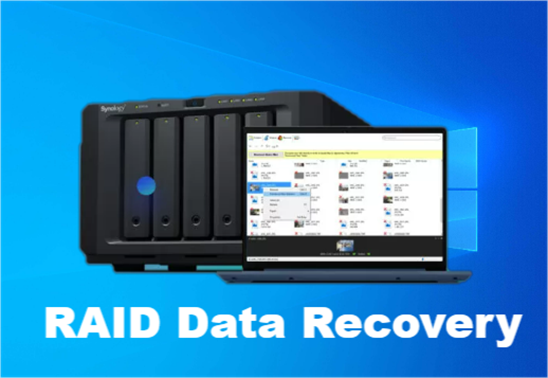Do you know any effective methods to recover RAID data effortlessly? Data security and integrity are crucial for both individual users and businesses alike. However, when utilizing RAID storage solutions, data loss can occur due to various factors such as hard drive failures or system issues. In such cases, it becomes essential to recover data from RAID drives to ensure the retrieval of valuable information. This article will delve into the world of RAID data recovery and provide insights into the best RAID recovery software available.
Is It Possible to Recover RAID Data?
Yes, it is possible to recover data from RAID drives. When data loss occurs in a RAID system due to hardware failures, accidental deletions, or other factors, there are methods available to recover RAID data.
However, it’s important to note that the success of RAID data recovery relies on various factors, such as the severity of the data loss, the specific RAID configuration, and the condition of the drives involved. while RAID data recovery is possible in many cases, there are situations where complete recovery may not be feasible. For example, if there is extensive physical damage to the drives or if the data has been overwritten.

Why Should Choose RAID Recovery Software to Recover RAID Data?
If you are wondering that how to recover data from RAID drives, It is a wise choice to use RAID recovery software. In fact, choosing RAID recovery software can be beneficial in the following ways:
- Ease of Use: The software is designed to be user-friendly, with intuitive interfaces and step-by-step instructions. It allows users with little technical expertise to easily navigate through the recovery process.
- Time Efficiency: It can quickly scan and analyze multiple drives simultaneously, reducing the time required for data reconstruction and recovery.
- Versatility: It is versatile and can handle different types of RAID configurations, including RAID 0, RAID 1, RAID 5, RAID 10, etc. It can also recover data from various storage media such as hard drives, SSDs, NAS devices, and RAID arrays.
- Cost Savings: Utilizing RAID recovery software can potentially save significant costs compared to hiring professional RAID recovery services. Software solutions are typically more affordable and provide a cost-effective option to recover RAID data, except in the case of severe physical damage to the drive or a complex RAID failure.
In summary, we would like to introduce Tenorshare 4DDiG Data Recovery Software as an effective solution to recover RAID data. This software is highly regarded as one of the best RAID recovery tools available. It offers a safe and secure way to recover deleted files from failed RAID drives, as well as Windows hard drives, external drives, memory cards, USB flash drives, and more.
3 Steps to Recover RAID Data Quickly and Easily
Here is a step-by-step guide to recover RAID data with the best RAID recovery software:
Step 1: Launch Tenorshare 4DDiG and connect your external hard drive to your PC. If you’re dealing with a RAID disk, select it and click on the Scan button.

Step 2: The software will initiate the scanning process on the chosen drive. You’ll see a progress bar indicating the scanning progress, along with the displayed data that has been found.

Step 3: Once the scan is complete, you can preview the files categorized by file type or directly search for specific files. Select the desired file(s) and click on the Recover button. Remember to choose a different location to save the recovered files.

So, with just a few simple clicks, you can easily recover data from RAID drives using this best RAID recovery software. Additionally, in case you’re unable to find the files using the default standard mode, the software also offers a Deep Scan mode. The deep scan utilizes a more advanced algorithm to discover a wider range of files from the RAID drive.
If you want to know more about recover data from external hard drive, please check this guide.
Things You Should Know about RAID Data Recovery
1.What is RAID?
RAID stands for “Redundant Array of Independent Disks.” It is a data storage technology that involves combining multiple physical hard drives into a single logical unit. The purpose of RAID is to improve data storage performance, data redundancy, or both.

2.What is Standard RAID Levels?
In a RAID configuration, the individual hard drives are organized and managed in specific ways to achieve different goals. There are several RAID levels, including RAID 0, RAID 1, RAID 5, RAID 10, and more. Each RAID level has its own characteristics and benefits:
- RAID 0: This level, known as striping, involves splitting data across multiple drives to enhance performance by allowing simultaneous read and write operations. However, RAID 0 does not provide redundancy, meaning that if one drive fails, all data in the RAID array is lost.
- RAID 1: Also known as mirroring, RAID 1 involves creating an exact copy (or mirror) of data on two drives. This provides redundancy, so if one drive fails, the data can still be accessed from the other drive.
- RAID 5: RAID 5 combines striping and parity to achieve both performance and data redundancy. Data is striped across multiple drives, and parity information is distributed among the drives as well. If one drive fails, the parity information can be used to reconstruct the lost data.

These are just a few examples, and if you want to know more about standard RAID levels, please read this one.
3.Reasons behind RAID Data Recovery
There are several reasons behind RAID data loss, which may necessitate the need for RAID data recovery. Some common causes include:
- Hardware Failures: RAID data loss can occur due to hardware failures such as a malfunctioning RAID controller, faulty hard drives, power surges, and more.
- Human Errors: Accidental deletion or formatting of RAID drives, improper RAID reconfiguration, or accidental overwriting of data can result in data loss in a RAID system.
- Software Corruption: RAID data can be lost or become inaccessible due to software issues such as operating system errors, file system corruption, or software bugs. Malware or viruses can also infect a RAID system, causing data loss or damage.
- RAID Rebuild Issues: During the process of rebuilding a RAID array after a drive failure or replacement, errors or interruptions can occur. If the rebuild process is not performed correctly, it can result in data loss or incomplete data recovery.
- Physical Damage: Physical damage to the RAID drives or the storage environment can lead to data loss.
If you are experience RAID data loss, you don’t need to worry. Try Tenorshare 4DDiG Data Recovery and you will recover RAID data in minutes.
4.Recover RAID 5 with 2 Failed Drives
Recovering data from a RAID 5 configuration with two failed drives raises important questions about data redundancy and performance. In this section, we will provide the answers you need.
When a drive fails in a RAID 5 setup, data availability is compromised. However, the situation becomes more challenging when multiple drives fail. So, how can you recover data from RAID 5 with 2 failed drives? Here’s a step-by-step approach:
Step 1:Start by restoring the backup data to a separate location, such as a spare drive.
Step 2:Verify the integrity of the backup data and ensure it is clean and complete before proceeding.
Step 3:Move on to the repair process. If a drive cannot be repaired, replace it with a new one.
Step 4:Test the performance of the replaced drives and ensure they meet the required standards for production.
Step 5:Upload the data to the newly configured RAID system.
Step 6:Conduct thorough testing again after uploading the backup data to ensure the system functions correctly.
By following these steps, it is feasible to recover RAID 5 with 2 failed drives.
Final Words about RAID Data Recovery
In summary, when dealing with RAID data loss caused by drive failures or system issues, using trustworthy RAID recovery software can greatly enhance the likelihood of successfully retrieving your data. Remember, if you find yourself in a situation where RAID data recovery is necessary, remain calm. For less severe cases, consider utilizing Tenorshare 4DDiG Data Recovery for assistance with RAID data recovery. However, if the situation is more severe, it is advisable to seek professional RAID recovery services.







Leave a Comment
You must be logged in to post a comment.